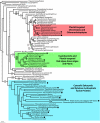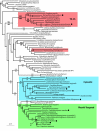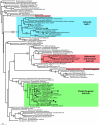A complex and punctate distribution of three eukaryotic genes derived by lateral gene transfer
- PMID: 17562012
- PMCID: PMC1920508
- DOI: 10.1186/1471-2148-7-89
A complex and punctate distribution of three eukaryotic genes derived by lateral gene transfer
Abstract
Background: Lateral gene transfer is increasingly invoked to explain phylogenetic results that conflict with our understanding of organismal relationships. In eukaryotes, the most common observation interpreted in this way is the appearance of a bacterial gene (one that is not clearly derived from the mitochondrion or plastid) in a eukaryotic nuclear genome. Ideally such an observation would involve a single eukaryote or a small group of related eukaryotes encoding a gene from a specific bacterial lineage.
Results: Here we show that several apparently simple cases of lateral transfer are actually more complex than they originally appeared: in these instances we find that two or more distantly related eukaryotic groups share the same bacterial gene, resulting in a punctate distribution. Specifically, we describe phylogenies of three core carbon metabolic enzymes: transketolase, glyceraldehyde-3-phosphate dehydrogenase and ribulose-5-phosphate-3-epimerase. Phylogenetic trees of each of these enzymes includes a strongly-supported clade consisting of several eukaryotes that are distantly related at the organismal level, but whose enzymes are apparently all derived from the same lateral transfer. With less sampling any one of these examples would appear to be a simple case of bacterium-to-eukaryote lateral transfer; taken together, their evolutionary histories cannot be so simple. The distributions of these genes may represent ancient paralogy events or genes that have been transferred from bacteria to an ancient ancestor of the eukaryotes that retain them. They may alternatively have been transferred laterally from a bacterium to a single eukaryotic lineage and subsequently transferred between distantly related eukaryotes.
Conclusion: Determining how complex the distribution of a transferred gene is depends on the sampling available. These results show that seemingly simple cases may be revealed to be more complex with greater sampling, suggesting many bacterial genes found in eukaryotic genomes may have a punctate distribution.
Figures




Similar articles
-
Eukaryotic origin of glyceraldehyde-3-phosphate dehydrogenase genes in Clostridium thermocellum and Clostridium cellulolyticum genomes and putative fates of the exogenous gene in the subsequent genome evolution.Gene. 2009 Jul 15;441(1-2):22-7. doi: 10.1016/j.gene.2008.03.001. Epub 2008 Mar 10. Gene. 2009. PMID: 18420358
-
Evolutionary analyses of the small subunit of glutamate synthase: gene order conservation, gene fusions, and prokaryote-to-eukaryote lateral gene transfers.Eukaryot Cell. 2002 Apr;1(2):304-10. doi: 10.1128/EC.1.2.304-310.2002. Eukaryot Cell. 2002. PMID: 12455964 Free PMC article.
-
Presence of a bacterial-like citrate synthase gene in Tetrahymena thermophila: recent lateral gene transfers (LGT) or multiple gene losses subsequent to a single ancient LGT?J Mol Evol. 2004 May;58(5):540-9. doi: 10.1007/s00239-003-2576-5. J Mol Evol. 2004. PMID: 15170257
-
Horizontal gene transfer between microbial eukaryotes.Methods Mol Biol. 2009;532:473-87. doi: 10.1007/978-1-60327-853-9_27. Methods Mol Biol. 2009. PMID: 19271202 Review.
-
Horizontal DNA transfer from bacteria to eukaryotes and a lesson from experimental transfers.Res Microbiol. 2015 Dec;166(10):753-63. doi: 10.1016/j.resmic.2015.08.001. Epub 2015 Aug 18. Res Microbiol. 2015. PMID: 26291765 Review.
Cited by
-
After the primary endosymbiosis: an update on the chromalveolate hypothesis and the origins of algae with Chl c.Photosynth Res. 2011 Jan;107(1):103-15. doi: 10.1007/s11120-010-9584-2. Epub 2010 Jul 30. Photosynth Res. 2011. PMID: 20676772 Review.
-
The endosymbiotic origin, diversification and fate of plastids.Philos Trans R Soc Lond B Biol Sci. 2010 Mar 12;365(1541):729-48. doi: 10.1098/rstb.2009.0103. Philos Trans R Soc Lond B Biol Sci. 2010. PMID: 20124341 Free PMC article. Review.
-
Chlamydial genes shed light on the evolution of photoautotrophic eukaryotes.BMC Evol Biol. 2008 Jul 15;8:203. doi: 10.1186/1471-2148-8-203. BMC Evol Biol. 2008. PMID: 18627593 Free PMC article.
-
Frequent, independent transfers of a catabolic gene from bacteria to contrasted filamentous eukaryotes.Proc Biol Sci. 2014 Aug 22;281(1789):20140848. doi: 10.1098/rspb.2014.0848. Proc Biol Sci. 2014. PMID: 24990676 Free PMC article.
-
Modulating host homeostasis as a strategy in the plant-pathogen arms race.Commun Integr Biol. 2009;2(2):89-90. doi: 10.4161/cib.7524. Commun Integr Biol. 2009. PMID: 19704897 Free PMC article.
References
Publication types
MeSH terms
Substances
Associated data
- Actions
- Actions
- Actions
- Actions
- Actions
- Actions
- Actions
- Actions
- Actions
- Actions
LinkOut - more resources
Full Text Sources
Medical
Research Materials

